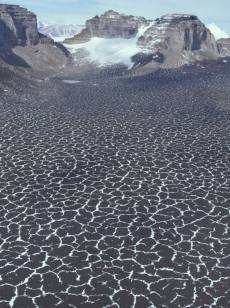Permafrost
Our studies in Antarctica investigate the complexities of permafrost and ancient ice.

Studies in permafrost and ancient ice relate directly to the aggradation and degradation of ground ice. The term "ground ice" refers to all types of ice formed in freezing and frozen ground. It ranges from disseminated ice crystals in the pores of soils or sediments (ice-cemented sediment) to thick (10-20 m), horizontally layered bodies of nearly pure ice (massive ice), which extend for several km². Ground ice can be divided into two broad categories: epigenetic and syngenetic. Epigenetic ground ice forms in situ as permafrost aggrades while syngenetic ground ice forms in combination with deposition. By definition, frozen ground or permafrost has existed below 0°C for over 2 years.
As water (either liquid or vapour) freezes in the ground, a complex set of processes determine the type of ice and the rate at which it forms. Although many types of ground ice are recognized, pore ice, wedge ice, segregated ice and massive ice are most significant in terms of volume and frequency of occurrence. Massive ice is defined as a large mass of ground ice having a gravimetric ice content >250%. One of the most widely used classifications for ground ice (Mackay, Annals, American Association of Geographers 62, 1972) identifies ten types of ice and three primary sources of water, but excludes buried ice. Buried ice is usually massive, but it originates above ground and becomes incorporated into the ground through burial processes. It includes glacial and lake ice, which in the Antarctic may be millions of years old.
Most of the literature relating to ground ice is based on observations from the northern hemisphere and little has come from Antarctica. However, with the recognized importance of Antarctica to global climate, the potential of paleoenvironmental information from ground ice has become a hot topic. Ground ice underlies most soils within one meter of the surface in the McMurdo Dry Valleys, Antarctica. The existence and persistence of this ice is of interest because ablation models suggest the ice should be absent in all but the youngest soils (>10,000 yrs), and yet, ice is ubiquitous under much older surfaces. Understanding the factors that lead to its formation and stability are also of interest because ground ice drives development of many landscape features. Furthermore, the Dry Valleys provides our best analogue for understanding the presence of ground ice on Mars.

A highly debated topic is the age and origin of buried ice, which is found in numerous locations throughout the Dry Valleys. We have identified three forms: ice-cored moraines from former cold-based glaciers, deposits of unknown ages from warm-based glaciers, and active debris-covered glaciers and gelifluction lobes. The surfaces of all three forms display polygonal patterned ground, which is a direct result of annual expansion and contraction of the ground ice. Some debris-rich ice is highly deformed, which may result from accumulated strain of multiple advances and retreats of cold-based glaciers. By analysing buried ice for chemistry and stable isotopes of oxygen and hydrogen we characterize it to help identify its source. We are also developing a method to analyse the gas composition of bubbles trapped in the ice. By using gas ratios we hope to distinguish between buried glacial ice and lake ice.
People involved
Current PhD students
